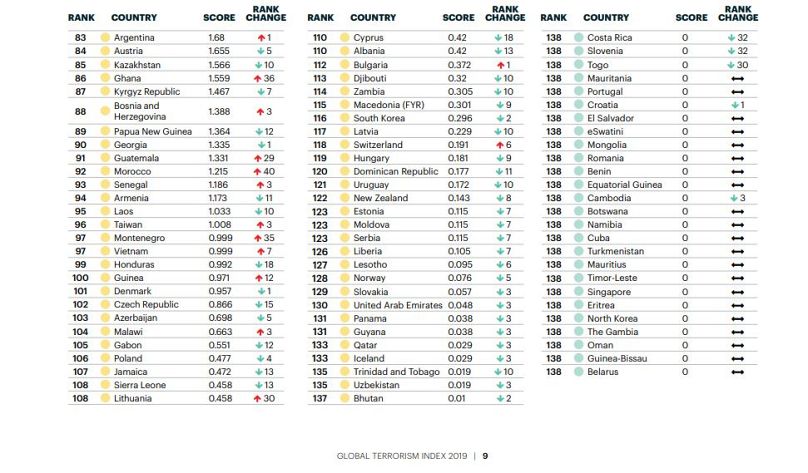Whilst still only a fraction of global terror deaths are attributed to the far-right, it is a growing menace in the west, rising 320% in the last five years.
Far-right terror is on the rise in the West, bucking the trend of declining rates of terror globally, an annual global report on terrorism shows.
The Global Terrorism Index (GTI) 2019, which recorded a decline in overall terrorism deaths for the fourth consecutive year, reported that far-right terrorism has increased by 320% in the last five years.
And the trend has worsened this year. In 2018 total deaths attributed to far-right groups increased to 26. As of the end of September this year, 77 deaths have been attributed to the far-right.
Elsewhere in the report, the United Kingdom was ranked above Ethiopia, Saudi Arabia, Israel and the Palestinian Territories in the annual list of countries most affected by terrorism.
The GTI ranks the UK as the 28th most-affected country in the world - the worst record for a western-European nation.
In Europe, only Turkey (16) and Ukraine (24) rank higher. The continent is the second-best performing region, after Central America and the Caribbean.
Other key findings from the report include:
• Overall terrorism deaths in 2018 (15,952) were 54% lower than their peak in 2014
• 71 countries experienced at least one death from terrorism in 2018
• Afghanistan had the worst deterioration in 2018, recording 7,379 deaths from terrorism, replacing Iraq the bottom of the index
• For the first time since 2003, Iraq was not the most-affected country
Far-right terror on the rise
Whilst still only a fraction of global terror deaths are attributed to the far-right, it is a growing menace in the west, rising 320% in the last five years.
Jacob Aasland Ravndal, a research fellow at the Center for Research on Extremism (C-REX) at the University of Oslo, told Euronews far-right violence is a “big universe of violence difficult to capture”.
He authored ‘Extreme-Right Violence and Terrorism: Concepts, Patterns, and Responses in 2019’, and while his study doesn’t have a concrete figure for far-right violence so far this year, he said six European countries stood out for being more violent: Sweden, Germany, UK, Spain, Italy and Greece.
“We are seeing a very recent trend to mass shootings linked with online internet forums. It is a transnational trend started with Christchurch in New Zealand, a few copycats in the US and now it has arrived in Europe with the Germany and Norway attacks.”
He points to some differences between the far-right in northern and southern Europe, with anti-immigrant feeling flaring up in recent years in the north, and the more traditional ongoing conflict between fascists and the leftwing in the south.
Tactics have changed considerably too: “People are sitting behind computers instead of being in the streets fighting each other. A lot of youths are politically engaged, they engage through the internet,” he said.
It is different from the skinhead movements of the past he added. “Violence is not at the core, but there is a more sophisticated approach to the struggle, they recruit more in universities than bars or football stadiums.”
What is the Global Terrorism Index?
The Global Terrorism Index is published by the Institute for Economics & Peace, a think tank headquartered in Australia.
It uses the Global Terrorism Database to rank countries by indicators including the number of terrorist incidents, fatalities, injuries and property damage.
Steve Killelea, executive chairman of IEP, explained the findings: “IEP’s research finds that conflict and state-sponsored terror are the key causes of terrorism. In 2018, over 95% of deaths from terrorism were occurring in countries that were already in conflict.
"When combined with countries with high levels of political terror the number jumps to over 99%. Of the 10 countries most impacted by terrorism, all were involved in at least one violent conflict last year.”
Taliban terror in Afghanistan
Afghanistan overtook Iraq as the country most affected by terrorism, with the report citing terror activity by the Taliban rising sharply in 2018 as the group carried out attack across the country.
The group were responsible for 6,103 deaths in 2018, a 71% increase from 2017. It is estimated that approximately half the population of Afghanistan reside in areas either controlled by the Taliban, or where they are active and regularly conduct attacks.
The ongoing defeat of militants from the so-called Islamic State (ISIS), as well as successful military campaigns against Al-Shabaab, has helped to continue the decline in terror deaths worldwide - and has led to the Taliban replacing ISIS as the world’s deadliest terror group in 2018












